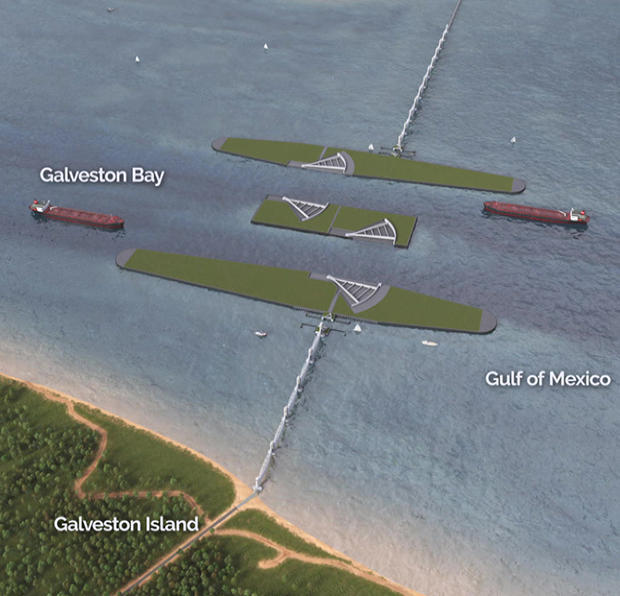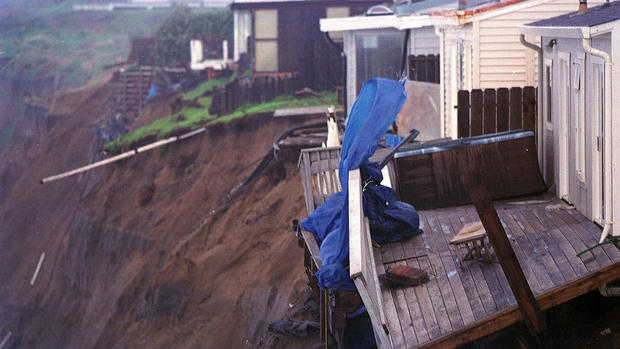Coastal residents on climate change: "The ocean's coming for you"
Thirty years ago Jim Hartshorne looked out at the endless expanse of blue water and decided North Carolina's Outer Banks felt like home. He said that back in 1993, sea level rise was not a concern. "I didn't think it would happen quite as quickly as what it did," he said. "I thought it wouldn't happen in my lifetime; I'd let the kids worry about it. But I've had to worry about it here the last ten years."
The ocean has become an increasingly greedy neighbor. Storms are more frequent, and more fierce. Parts of these Barrier Islands have retreated more than 200 feet in the last two decades. Some beaches are now losing about 13 feet a year, according to the National Park Service.
This past summer, video of the Atlantic claiming yet another beach house in Rodanthe, just up the road from Hartshorne, went viral on Twitter.
Hartshorne said, "You gotta take the good with the bad. It's wonderful to be out here. It's pretty. But you have to know the ocean's coming for you."
He's trying to delay that day by reinforcing the pilings that hold up his house, and rebuilding a staircase; the old one washed away during a recent storm. He said he's spent between $20,000 and $22,000 this year alone repairing storm damage.
Hartshorne and his neighbors are getting help from North Carolina's Dare County, which is spending $25 million to widen 12 miles of coastline along the Outer Banks.
A few months ago waves were hitting Hartshorne's pilings; now he has a six-foot-tall dune and a few hundred feet of new beach.
The county also spent $155 million to build the Rodanthe Bridge because Highway 12, the only way in and out, kept flooding. Years ago, the historic Cape Hatteras Lighthouse was moved nearly 3,000 feet inland, an ironic warning of the dramatic climatic changes to come.
"You're not going to stop the ocean; you're not going to completely engineer your way out of this challenge," said Reide Corbett, who runs the Coastal Studies Institute on the Outer Banks. "We will have to think about how we move infrastructure, how we move people.
"Yes, sea level has changed in our past, but it's changing at a rate that we haven't seen before."
Corbett took "Sunday Morning" out to the marsh where he and other scientists collect soil samples that are a peek into the past. He says their research shows the rate of sea level rise here has doubled in the past 100 years.
"That's pretty aggressive acceleration," said Tracy.
"Yeah, and we're just starting to see the ramp," Corbett said. "We're looking at a foot rise in the next 30 years. That's going to impact most homeowners on the Outer Banks during their mortgage. And so, it's not about putting it off to the next generation. It's happening today. We're seeing those impacts today."
Sea level rise is accelerating due to global warming caused mainly by the burning of fossil fuels. It's causing the world's ice sheets and glaciers to melt.
A new NASA report says sea levels along U.S. coastlines are expected to rise as much as 12 inches by 2050, with the Southeast and Gulf Coasts seeing the most change.
By 2100, 13 million Americans could be displaced, and $1 trillion worth of property inundated.
- NASA Study: Rising Sea Level Could Exceed Estimates for U.S. Coasts
- 13 million Americans could become climate refugees (CBS News)
East Coast cities such as Miami are already struggling with flooding even on sunny days, and hurricanes and storm surge along the Gulf Coast are expected to get more intense.
- Rising tides force Miami Beach residents to seek higher ground ("CBS Evening News")
- How climate change is making storms like Hurricane Ian stronger more quickly (CBS News)
- Sea level rise could destroy 20% of the world's GDP by 2100 (Moneywatch)
In Galveston Texas, the Army Corps of Engineers is planning to build a system of massive gates (designed to fend off 22 feet of storm surge), and 43 miles of sand dunes (to protect against rising seas and stronger hurricanes). The project is estimated to cost $31 billion.
"The intent here is to provide multiple lines of defense," said Kelly Burks-Copes, who is with the Corps' Galveston District. "It will be the largest infrastructure project in the nation for the next 20 years."
Tracy asked, "Is this where we're at with climate change, that we have to do things like this?"
"I think that it's a necessity, if we're going to continue to live close to the ocean. If we want to live here on the coast, then we have to provide a level of defense."
- The $29 billion plan to save Texas' coast from rising tides ("CBS Evening News")
- Sea change: How the Dutch confront the rise of the oceans ("Sunday Morning")
Jane Tollini thought she had it made, living high above the Pacific on the cliffs of Pacifica, California. "There was a 20-foot front yard, a 900-square-foot house, then there was like maybe 25, 30 feet until you came to this white picket fence in the backyard," she said. "And it felt like I could get drunk, roll out the door, hit the fence, and I would be safe. I thought I was golden!"
She was wrong. Punishing El Niño storms in 1998 turned her California dream home into a nightmare. She woke up one morning to find her backyard was gone. "There was nada, nothing, zip," she said. "And it was terrifying. Now if somehow this idiot had gotten up, walked to that sliding glass door, opened it, and stepped out, I would've stepped into space. That's how undercut I was.
"I was like, how did this happen, and so quickly? And I slept through most of it."
That morning she called friends to help her quickly move out before her house, and 12 others, had to be torn down and pushed into the ocean. Since then, entire apartment complexes have realized that they, too, picked a losing fight with the Pacific. Of course, erosion has always been a part of life on the West Coast, but scientists say climate change is accelerating it, threatening nearly all of California's 1,000 miles of coastline and billions of dollars' worth of real estate.
- El Niño storms leave Calif. residents living on the edge – literally ("CBS Evening News")
- Erosion threatens scenery and real estate along iconic California coastline ("CBS This Morning")
Tollini said, "If you believe there is going to be more water, then there is going to be less land on every coast around the world."
And having lived on the leading edge of climate change, Tollini has no doubts about who has the upper hand: "Mother Nature's always gonna win. And she has got a bone to pick with the human race. And I don't blame her."
For more info:
- Coastal Studies Institute, Wanchese, N.C.
- Army Corps of Engineers, Galveston District
Story produced by John Goodwin. Editor: Karen Brenner.
See also:
- With climate change, crops migrate north ("Sunday Morning")
- Due to climate change, Nevada says goodbye to grass ("Sunday Morning")
- Suing over climate change: Taking fossil fuel companies to court ("Sunday Morning")
- For many climate change finally hits home ("Sunday Morning")
- Al Gore's climate crusade ("Sunday Morning")









